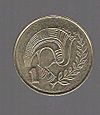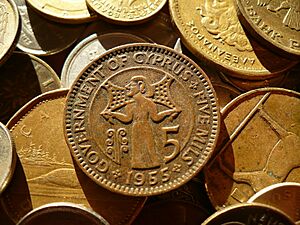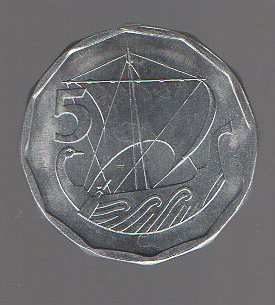Coins of the Cypriot pound facts for kids
The coins of the Cypriot pound were the physical money used in Cyprus before the country started using the Euro in 2008. These coins were first made in 1878 when Cyprus was under British rule.
Contents
Old Cypriot Coins (Before 1955)
Before 1955, the Cypriot pound was divided differently. One pound was worth 20 shillings, and each shilling was worth 9 piastres.
The British government first made coins for Cyprus in 1879. These were bronze piastres. They showed Queen Victoria's head on one side and the word 'Cyprus' on the other. At first, some people in the British government wondered if it was legal to make coins for Cyprus, as it was still technically part of the Ottoman Empire.
Over the years, coins were made featuring different British monarchs:
- Queen Victoria (1879–1901)
- King Edward VII (1902–1908)
- King George V
- King George VI (1938–1947)
- King George VI (1949)
Decimal System: Mils (1955–1982)
In 1955, Cyprus changed its money system to a decimal one. This meant that one pound was now divided into 1000 mils. This "mil" system was actually suggested for the United Kingdom a long time ago, in 1881, but it was never used there. Instead, it was used in some British territories like Palestine and then Cyprus.
Coins of Queen Elizabeth II (1955–1957)
In 1955, the older coins were taken out of use. New coins featuring Queen Elizabeth II were introduced. These new coins were in mils.
The coins made were:
- 3 mils
- 5 mils (also made in 1956)
- 25 mils
- 50 mils
- 100 mils (also made in 1957)
People often called the 50 mil coin a 'shilling'. This was because it was the same size as the old 1 shilling coin. The 100 mil coin was called '2 shillings' for the same reason. The 5 mil coin from 1956 and the 100 mil coin from 1956 are quite rare and popular with coin collectors.
Coins of the Republic of Cyprus (1963–1982)
When Cyprus became an independent country in 1960, the Queen Elizabeth II coins continued to be used for a while.
In 1963, the new Republic of Cyprus started making its own coins. These coins were made at the Royal Mint in London. The first coins issued in 1963 were:
- 1 mil
- 5 mils
- 25 mils
- 50 mils
- 100 mils
Later, in 1970, 500 mil coins were also made. The 1970 500 mil coin was special. It celebrated the F.A.O. (Food and Agriculture Organization) and the 25th birthday of the United Nations. Other 500 mil coins were also made later.
In 1976, a 1-pound coin was made. This coin honored the refugees from the 1974 Turkish invasion.
A very special gold 50 pounds coin was made in 1977. This coin was made to remember Archbishop Makarios III. He was the President of Cyprus until he passed away.
In 1981 and 1982, some 5 mil coins were made with the name 'Cyprus' written in three languages: 'Kypros' in Greek, 'Cyprus' in English, and 'Kıbrıs' in Turkish.
Archbishop Makarios III Medal-Coins
Special medal-coins featuring President-Archbishop Makarios III were made twice. The first set was made in 1966, and the second in 1974.
The back of these medal-coins showed the Palaeologus Byzantine double-headed eagle. These unique coins are listed in a special catalogue for "Unusual World Coins."
Decimal System: Cents (1983–2008)
On October 3, 1983, Cyprus changed its money system again. This time, one pound was divided into 100 cents.
New coins were made for ½, 1, 2, 5, 10, and 20 cents. The ½ cent coin was the same size and material as the old 5 mil coins. The other coins were made of nickel-brass. The ½ cent coin was only made in 1983. In 1991, new 50 cent coins were introduced. These were seven-sided and made of cupronickel.
| Decimal cent series [1] | ||||||||||||
|---|---|---|---|---|---|---|---|---|---|---|---|---|
| Image | Value | € equiv. | Technical details | What they looked like | Dates | Nickname | ||||||
| Diameter | Thickness | Mass | Material | Front | Back | First made | Taken out of use | No longer valid | ||||
| [2] | ½ cent | 0.85 cent | 20 mm | 1.2 g | Aluminium | "CYPRUS·ΚΥΠΡΟΣ·KIBRIS", Cyprus Coat of Arms, year | Cyclamen flower | 1983 | 1 October 1992 | 1 December 2001 | μισούι | |
  |
1 cent | 1.71 cent | 16.5 mm | 1.35 mm | 2 g | Copper, zinc, nickel | "CYPRUS·ΚΥΠΡΟΣ·KIBRIS", Cyprus Coat of Arms, year | Value, a bird in front of a tree branch (from an old jug) | 1983 | 31 January 2008 | 31 December 2009 | μονό, μονόσεντο |
| 2 cents | 3.42 cent | 19 mm | 1.25 mm | 2.5 g | Value, two goats (from an old bowl) | διάρι, δίσεντο | ||||||
| 5 cents | 8.54 cent | 22 mm | 1.4 mm | 3.75 g | Value, a bull's head (from an old silver bowl) | πεντάρι, πεντάρικο, σελίνι | ||||||
 |
10 cents | 17.09 cent | 24.5 mm | 1.7 mm | 5.5 g | Value, a modern clay vase from Phini with flowers and birds | δεκάρικο, διπλοσέλινο, τσιφτές | |||||
| 20 cents | 34.17 cent | 27.25 mm | 1.8 mm | 7.75 g | Value, a sparrow on an olive branch | εικοσάρικο, τετρασέλινο | ||||||
| [3] | "ΖΗΝΩΝ Ο ΚΙΤΙΕΥΣ", Zeno of Citium (a philosopher) | 1989 | ||||||||||
| [4] | 50 cents | 85.43 cent | 26 mm | 1.8 mm | 7 g | Cupronickel | "CYPRUS·ΚΥΠΡΟΣ·KIBRIS", Cyprus Coat of Arms, year | A picture based on an old 4th-century BC Cypriot coin. It shows Europa being carried away by Zeus (who looks like a bull). It also has "King Timocharis" written in an old Cypriot writing style. | 1991 | 31 January 2008 | 31 December 2009 | πενηντάρικο, δεκασέλινο |
| These images are to scale at 2.5 pixels per millimetre. For table standards, see the coin specification table. | ||||||||||||
The last 20 cent coin had a different design on its back. It showed the head of a Cypriot philosopher named Zeno of Citium.
When they were brand new, the 1, 2, 5, 10, and 20 cent coins all looked bright golden. The 50 cent coin had a special seven-sided shape and was bright silver.
See also



